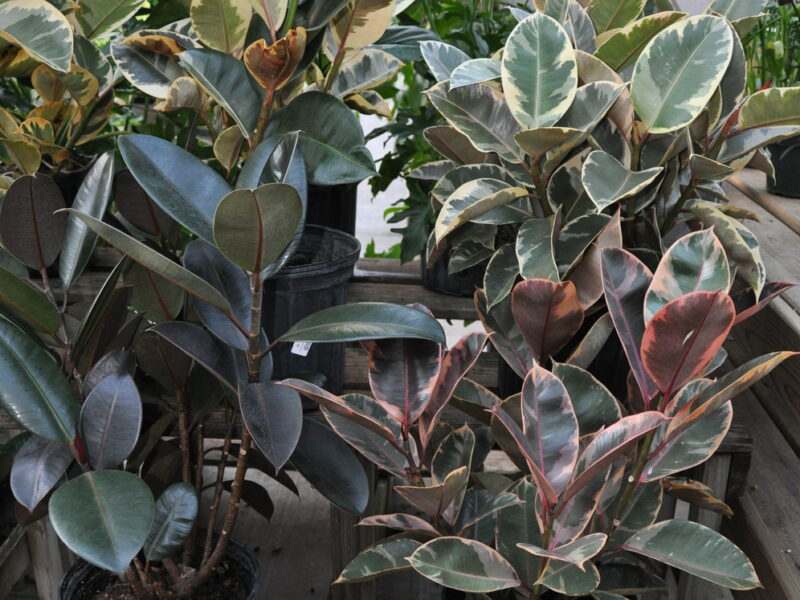

Last week, we began to take a look at houseplants, also known in the trade as “tropical foliage.” I noted that this is a great time of the year to be buying them. But which are best and will survive in your home? Simply because they are for sale in a plant shop or garden center by no means indicates that they are the right choice.
And yes, I will go over the worst houseplants, as well.
Among the more popular houseplants — and the ones I highly recommend — are from the Ficus, or fig, family. The most common are the fiddle leaf fig (Ficus lyrata), weeping fig (Ficus benjamina) and the rubber tree (Ficus elastica, often sold under the variety “Decora”). All produce a sticky, milky sap that contains latex — the substance used to make natural rubber — and is often referred to as “white gold.” All the Ficus plants may be toxic to humans and pets, so don’t eat them and be cautious with children and pets who misbehave with our plant friends.
The most temperature sensitive of the group is the weeping fig, but it can also be the most decorative with its tall, braided trunks. This fig requires bright light, but it will do well to the side of a sunny window. And please keep in mind that when I mention bright light, this isn’t full sun. Rather, it’s to the left or right of a window that may get full sun for most of the day. The plants can grow quite tall, though, and a plant purchased in a 6-inch pot that’s about a foot tall will be 6 feet tall in several years if it’s repotted as it grows.
Unlike the other Ficus, this one does shed leaves naturally, but it doesn’t make a mess. On the other hand, if subjected to sudden cold or moved into a cold area, it will quickly drop leaves in response. It does best around 65 to 75 degrees; while it will tolerate letting the soil dry out, it shouldn’t be left constantly dry. Let the soil surface dry (use the finger test) and, when needed, water from the bottom.
As this plant fills the pot, you’ll find it will need watering almost daily and this is a good sign that it’s time for repotting. It’s subject to the three common houseplant insects: mealybugs, spider mites and scale. The stems can get a bit bumpy, like it has pimples and moles, so make sure you’re not mistaking these for scale.
Don’t move this plant outdoors then indoors. The change will result in leaf drop. If it’s happy — meaning it’s not dropping leaves and growing an inch or more a month — just leave it be. Remember to give it a quarter turn each week to keep the growth symmetrical. It’s a light feeder and if you notice small pea-sized dark berries forming; these are the fruits.
The fiddle leaf fig has fiddle-shaped foliage about the size of, well, a fiddle. It has a reputation of being finicky, but for some reason, I’ve found it to probably be the least finicky of the three figs discussed, and can often be left in the same large pot in the same spot for years before it simply gets too tall for its space. It adapts well to filtered light, most home temperatures and humidity.
This plant is sensitive to overwatering, so be on the lean side until you get to know each other. The stems and branches can get heavy, so as the plant grows, it may need some discreet staking for support. And since it has such large leaves, it can be a dust collector, so every month or so, use a damp cloth with warm water to clean the leaves.
It is also sensitive to salt buildup. Once every five or six weeks, let the soil dry out and then flush it with water. You can also reduce salt buildup by using organic fertilizers, not chemical fertilizers. A fertilizer with a ratio of about 4-1-3, or a similar balance of nitrogen, phosphorus, and potassium (NPK), works well.
Ficus elastica is probably the most well-known of the figs. It can grow up to 10 feet tall, though in nature, it grows much taller. The traditional color of the foliage is a glossy dark green to bronze. However, there are several variegated varieties that include pinks, cream and near white in their leaves that add great color variations to the foliage. Keep in mind though, as with all variegated houseplants, that the more light the plant gets, the more its colors will develop. If you put this plant in low light, the variegation or leaf color will revert to green or nearly brown.
When this plant gets too tall — and they all do — the top can be cut off and rooted in a pot of soil inside a plastic bag, or you can use a technique known as air layering, which can be slower but much safer than simply cutting off the top and rooting it in a pot. But both methods accomplish the same thing. Cutting the stem, or leader, at any point will cause new shoots to emerge below the cut, but this usually results in a weird-looking plant if you don’t know what you’re doing.
Common to all the Ficus is that once pot bound, they will begin to drop their lower leaves to compensate for the inability to grow new roots as the plant gets larger. All three will be subject to the insects noted in Ficus benjamina. However, all these plants will respond well to an occasional light spray of horticultural oil (make sure you use the right one), which will shine the leaves and smother any lingering insects. This is best done in May or early September if you can get the plant outdoors.
If you want to take any of these plants outdoors for the summer, do this when it stays consistently warm at night — never below 60 degrees — and start in a shady spot before you give the plant more light. They will all be subject to sunburn if you just bring them out and park them in a sunny spot without any acclimatization. A few weeks before you bring them back inside in mid to late September, reverse the process and give them increased lower light for a couple of weeks first.
How will you do best with these plants? Start with small ones, let them grow up where you want them to live and repot as necessary. Small means 4-to-6-inch pots, then bump them up as needed, but return them to the same growing spot.
No matter where you buy your houseplants, you’ll find that for the most part, there are few new plants under the sun. Retailers don’t like to take chances with plants that gardeners aren’t familiar with. However, there’s a very big world of houseplants for all levels of indoor gardeners beyond the local plant shop or garden center. Take a look at Logee’s Greenhouses offerings (logees.com) and you’ll find a very addictive collection of plants you can grow indoors and, quite literally, fill your house with plants.
The other thing I like about Logee’s is that they are in Connecticut, so more often than not, it only takes two days for the plants to reach us out here. It’s a great opportunity to expand your houseplant collection — and October is still a very safe month for shipping without the fear of cold damage.
Keep growing.
Garden Notes
I hope you’re not still putting your leaves in the trash, or letting your town or village pick them up. The mix of many types of deciduous tree leaves that are falling to the ground can be the backbone of your composting — and I can’t say enough about compost.
The most highly recommended leaf and branch shredder is a Worx WG430, which is electric, so you need to be near an outlet or have the right extension cord. Using this small shredder will allow your compost to cook faster. At $180 or less, it’s great for a property of small acreage and it’s less than 20 pounds, so easily lifted and moved. Every other chipper/shredder I like costs thousands of dollars.
If you have an irrigated lawn, or think we’re going to get rain, this is the time to fertilize. Once now and then, again, late in the spring may be all you need — despite what your landscaper might say. Use an organic lawn fertilizer, as they last longer and are less of a pollution threat to our groundwater.
 More Posts from Andrew Messinger
More Posts from Andrew Messinger